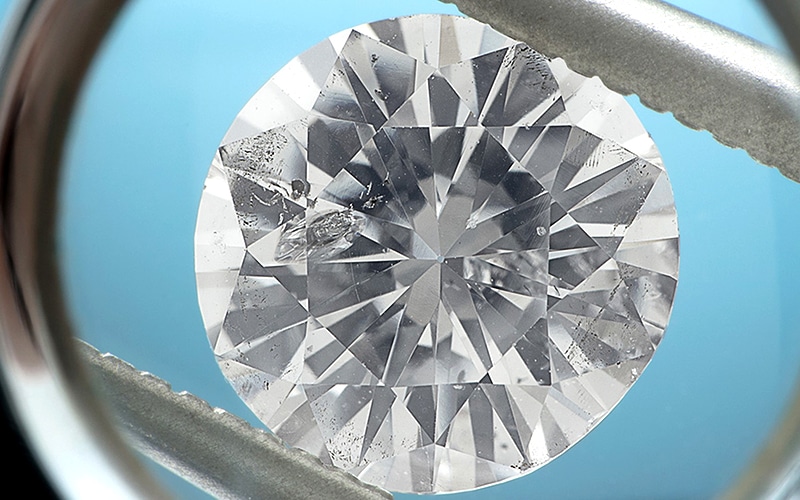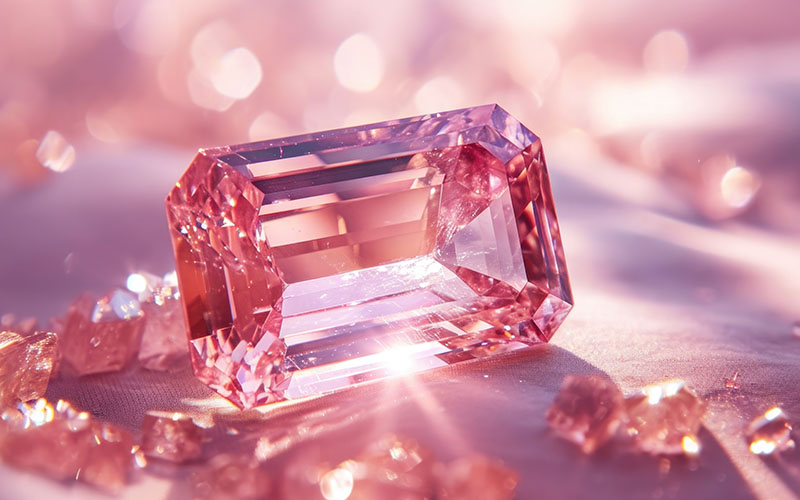Nature’s birthmarks? Or unsightly specks?
What do you think? There’s no wrong answer but there are many different philosophies regarding natural diamond and gemstone clarity. Should a diamond be allowed to have few blemishes, or should it be as clean as the pure driven snow?

Clarity Definition
Clarity evaluates a gemstone’s internal and external clarity-characteristics. Internal characteristics are called inclusions. These can be elements which were trapped in the stone as it grew, or structural defects in the crystal lattice. External characteristics are classified as blemishes. These can be growth-related or they can be caused during wear.
Yes, even a diamond can develop wear-and-tear issues as it walks through life. Earrings stored together can scratch each other. Scratches and nicks can occur if diamonds in bands worn next to each other have their girdles rubbing together. And even the most flawless diamond can chip if it takes a knock against a hard surface the wrong way.
Learn With Videos: 2-Minute Clarity Refresher
Clarity Grading
A gemologist analyzes clarity by looking down through the top of the stone at 10-power magnification. All inclusions and blemishes seen at 10-power are considered when deciding the clarity grade.
- A gemstone with no characteristics visible at 10 power magnification, is considered flawless, and a gemstone with surface blemishes but no inclusions can be graded internally flawless.
- A stone with minute characteristics, difficult to find even at 10 power, is Very Very Slightly Included. VVS1 is closest to flawless, followed by VVS2, which is still quite rare.
- A stone with minor characteristics seen at 10 power magnification, is Very Slightly included, also divided into VS1 and VS2.

- A stone with characteristics quickly noticeable at 10 power is Slightly Included, divided into SI1 and SI2.
- And finally, stones with characteristics large or abundant enough to be obvious at 10 power magnification (and possibly without magnification) are considered “Included.” Divided into I1, I2 and I3.
In addition to visibility at 10 power magnification, gemologists also consider Location, Number, Color, Size and the Nature of inclusions and blemishes when deciding the final clarity grade.
For example, the Nature of a pinpoint (like a tiny speck) is benign, but the Nature of a feather (a crack in the crystal) may reduce the clarity grade beyond its visibility implications – potentially to the lowest “Included” grades, should it threaten the diamond’s durability.
The “Eye-Clean” category
Many people aren’t concerned with the VS or VVS or SI of it all. They just want their gemstones to be “eye-clean,” with nothing to distract from the material aesthetic.
What is “eye-clean?” According to a survey of gemologists, the definition of eye-clean is as follows:
No inclusions visible to the unaided eye when viewed from the face up position in daylight equivalent or fluorescent lighting from approximately 6-12 inches from the eye using 20/20 vision.

Laboratories analyze at 10X magnification and set the clarity grade using that view. They don’t make “eye-clean” judgments, due to the variables. This means fans of eye-clean diamonds can find “hidden treasure” in the SI1 and SI2 grades: Diamonds with no visible inclusions, just as clean as VS, VVS and Flawless diamonds to the naked eye, for tremendous savings.
Diverse philosophies
A lot of diamond buyers have preconceived notions about clarity. These may have to do with what someone learned growing up, what their circle of friends and family say, or gleaned from information they read on the internet (hello).
High Clarity Opinions
High clarity diamonds perform better: – FALSE. If you’re sticking with VVS because you think it sparkles better than SI1 you can stand down. A diamond’s qualities of brightness, dispersion and scintillation are attributable to cut-quality. Diamonds cut the same way will sparkle the same way at Flawless, VVS, VS and even clean SI clarities. Transparency plays a part so when considering SI1-SI2 diamonds and below be aware of clouds and haze, but – as a rule – diamond with clarity characteristics which interfere with light transmission or threaten durability are relegated to the lowest grades of I1-I2-I3.
High clarity diamonds have more value: + TRUE. Diamonds which combine D, E or F color with Flawless, IF, VVS1 or VVS2 clarity are considered “collection quality” diamonds which (a) tend to hold their value best over time and (b) have special status in the eyes of diamond professionals, collectors and enthusiasts. Some people choose high-clarity and high-color combinations for this logical reason.

High clarity symbolizes our union: MAYBE? Depending on culture and philosophy, diamonds have been said to be reflections of the relationship they symbolize. In such cases the choice of high clarity is a no-brainer for those who believe their union is perfect and pure, although, I know a few couples who can get by exchanging SI2 diamonds.
Just kidding!
Low Clarity Leanings
Inclusions are Nature’s Birthmarks: + WHY NOT? Some people especially attuned to nature consider a diamond or gemstone’s inclusions birthmarks from nature which make them unique. There is a practical side to this philosophy. A diamond with inclusions you can manage to spot without a loupe or microscope is quickly identifiable upon retrieval, should you have it cleaned by a friendly jeweler.

“Prongable” Inclusions are Budget Friendly: + TRUE. Sometimes a visible inclusion which is close to the edge of the diamond (the girdle) can be covered with one of the ring’s prongs, making it totally invisible. Such finds are great for people shopping on a budget who wish to maximize the size of their purchase by dropping to lower clarities. Just be sure that “prongable” inclusion isn’t one that will expand or fracture as setting pressure is applied.
Low Clarity and Advancing Age = GREAT NEWS for everyone in their 50s and older. All human beings are subject to the effects of presbyopia as we age. This is an increasing degree of farsightedness caused by loss of elasticity of the lens of the eye. It’s why you may not be able to read the print on a dime any longer – but it also means many of the diamond inclusions you could spot in your 20s and 30s will now be invisible. YES!

What do you think?
Nature’s birthmarks? Or unsightly specks? What about a ruby-red garnet trapped inside a colorless diamond?
Would you?





